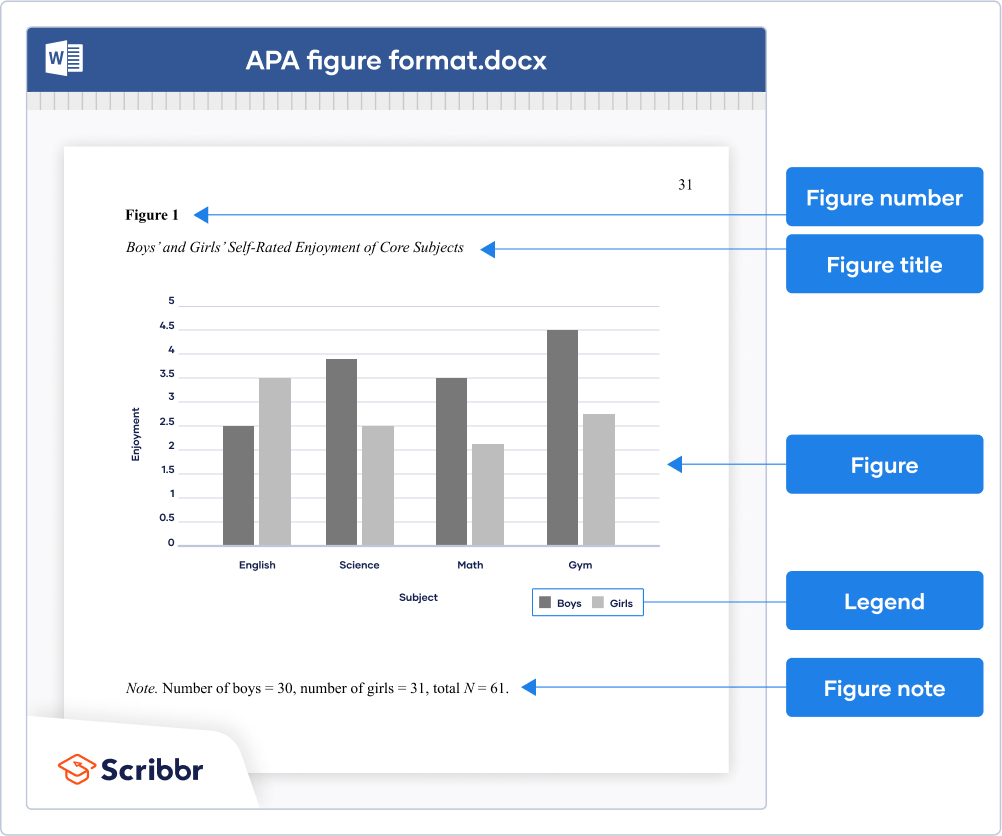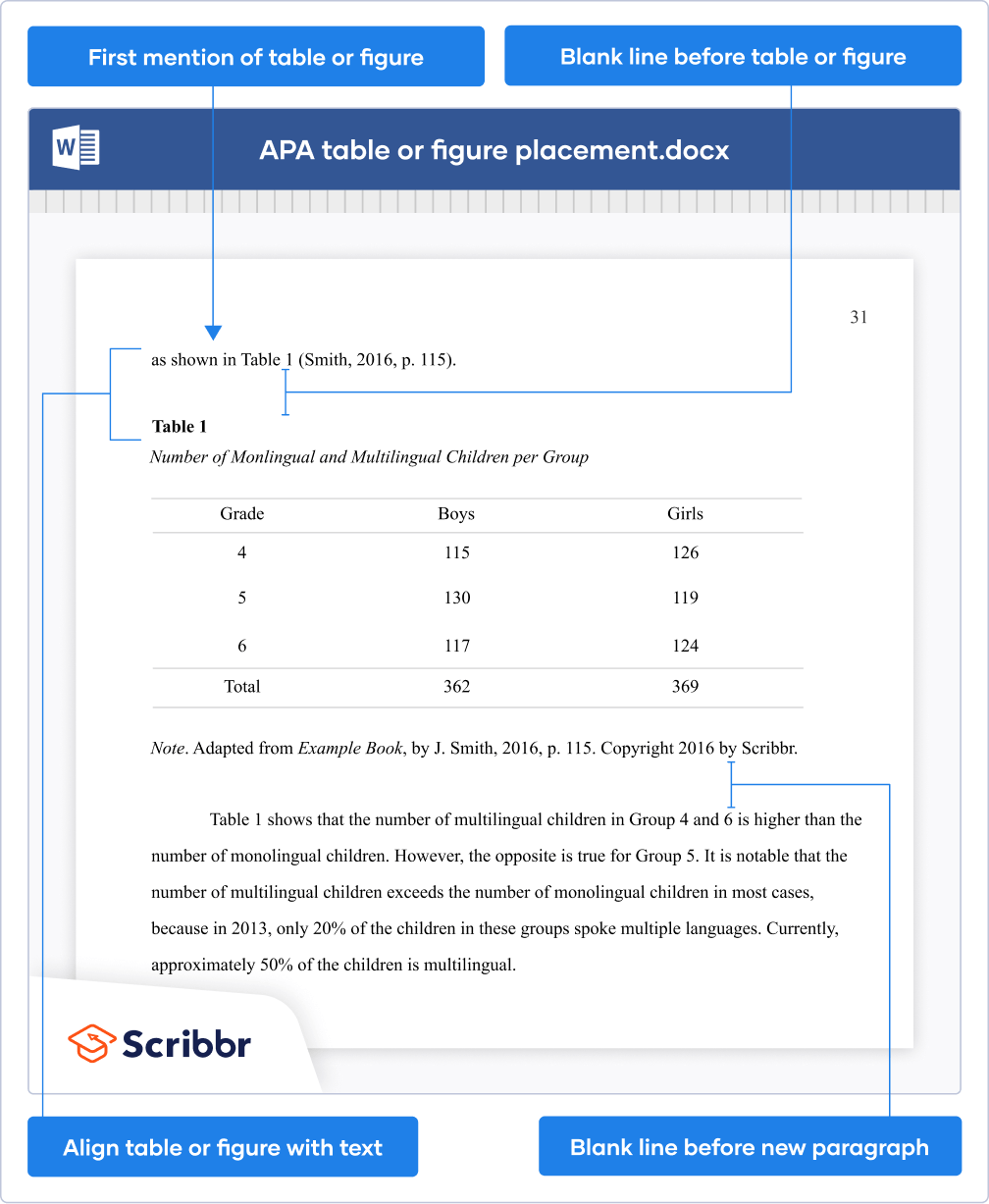Intext Book Citation Apa Multiple Authors Literature Review
APA Format for Tables and Figures | Annotated Examples
A tabular array concisely presents information (often numbers) in rows and columns. A figure is any other epitome or illustration you include in your text—anything from a bar chart to a photograph.
Tables and figures differ in terms of how they convey data, just APA Way presents them in a like format—preceded by a number and title, and followed by explanatory notes (if necessary).
APA tabular array format
Tables volition vary in size and structure depending on the data you're presenting, merely APA gives some full general guidelines for their design. To correctly format an APA table, follow these rules:
- Table number in assuming above the table.
- Brief title, in italics and championship case, beneath the table number.
- No vertical lines.
- Horizontal lines just where necessary for clarity.
- Clear, concise labels for column and row headings.
- Numbers consistently formatted (due east.g. with the same number of decimal places).
- Whatsoever relevant notes below the tabular array.
An example of a table formatted co-ordinate to APA guidelines is shown below.

The tabular array above uses only four lines: Those at the top and lesser, and those separating the primary information from the column heads and the totals.
Create your tables using the tools congenital into your word processor. In Word, y'all can apply the "Insert table" tool.
APA figure format
Whatever images used within your text are chosen figures. Figures include data visualization graphics—e.g. graphs, diagrams, flowcharts—as well as things like photographs and artworks.
To correctly format an APA figure, follow these rules:
- Figure number in assuming higher up the figure.
- Brief title, in italics and championship example, under the effigy number.
- If necessary, articulate labels and legends integrated into the image.
- Any relevant notes below the figure.
An example of a figure formatted co-ordinate to APA guidelines is shown below.

Keep the design of figures every bit simple every bit possible. Apply colors only where necessary, not simply to make the image look more than appealing.
For text within the image itself, APA recommends using a sans serif font (due east.g. Arial) with a size between 8 and 14 points.
For other figures, such as photographs, you won't need a legend; the figure consists merely of the prototype itself, reproduced at an appropriate size and resolution.
Are your APA in-text citations flawless?


The AI-powered APA Commendation Checker points out every mistake, tells you exactly what's wrong, and explains how to set up it. Say farewell to losing marks on your consignment!
Get started!

Numbering and titling tables and figures
Each table or effigy is preceded by a number and championship.
Tables and figures are each numbered separately, in the order they are referred to in your text. For example, the start table you lot refer to is Table 1; the fourth figure y'all refer to is Figure 4.
The title should conspicuously and straightforwardly describe the content of the table or figure. Omit articles to keep it concise.
The tabular array or figure number appears on its own line, in bold, followed by the title on the following line, in italics and championship case.
Literacy Rates in European Countries
Formatting table and effigy notes
Where a tabular array or figure needs further explanation, notes should be included immediately afterward information technology. These are not your analysis of the information presented; salve that for the main text.
There are three kinds of notes: general, specific, and probability. Each blazon of annotation appears in a new paragraph, merely multiple notes of the same kind all announced in one paragraph.
Only include the notes that are needed to understand the tabular array or effigy. Information technology may exist that it is clear in itself, and has no notes, or simply probability notes; be as concise as possible.
General notes
General notes come up get-go. They are preceded by the word "Note" in italics, followed past a period. They include whatever explanations that utilise to the table or effigy equally a whole and a citation if it was adapted from another source, and they end with definitions of any abbreviations used.
Specific notes
Specific notes refer to specific points in the table or figure. Superscript letters (a, b, c …) appear at the relevant points in the table or effigy and at the start of each note to signal what they refer to. They are used when it'south necessary to comment on a specific information betoken or term.
Probability notes
Probability notes give p-values for the data in the table or figure. They represent to asterisks (and/or other symbols) in the tabular array or effigy.
Where to identify tables and figures
You take two options for the placement of tables and figures in APA Style:
- Option 1: Identify tables and figures throughout your text, shortly after the parts of the text that refer to them.
- Option ii: Place them all together at the end of your text (afterwards the reference listing) to avoid breaking upwards the text.
If you place them throughout the text, note that each table or figure should only appear once. If you refer to the same table or figure more than than once, don't reproduce it each time—just place it later the paragraph in which it'southward first discussed.
Align the table or figure with the text forth the left margin. Get out a line break before and after the tabular array or figure to clearly distinguish it from the primary text, and identify it on a new page if necessary to avoid splitting information technology across multiple pages.

If you place all your tables and figures at the end, you should have i table or figure on each folio. Begin with all your tables, so place all your figures afterwards.
Referring to tables and figures in the text
Avoid making redundant statements near your tables and figures in your text. When you lot write almost data from tables and figures, it should exist to highlight or analyze a particular data point or trend, not simply to restate what is already clearly shown in the table or figure:
- Equally Tabular array 1 shows, in that location are 115 boys in Course 4, 130 in Course v, and 117 in Grade half dozen …
- Table ane indicates a notable preponderance of boys in Grade 5. Information technology is important to take this into account because …
Additionally, even if you lot have embedded your tables and figures in your text, refer to them by their numbers, not by their position relative to the text or past clarification:
- The tabular array below shows…
- Table 1 shows…
- As can be seen in the image on page 4…
- As tin exist seen in Figure 3…
- The photograph of a bald eagle is an example of…
- Figure 1 is an example of…
Ofttimes asked questions about APA tables and figures
- When should I apply a tabular array or figure to present data?
-
In an APA Style paper, use a tabular array or figure when it'south a clearer way to present important information than describing information technology in your master text. This is often the case when you lot need to communicate a large amount of information.
Before including a table or figure in your text, always reflect on whether it'south useful to your readers' understanding:
- Could this information exist chop-chop summarized in the text instead?
- Is it important to your arguments?
- Does the tabular array or figure crave too much explanation to exist efficient?
If the data you need to present simply contains a few relevant numbers, try summarizing information technology in the text (potentially including full information in an appendix). If describing the information makes your text overly long and hard to read, a table or effigy may be the best choice.
Is this article helpful?
You have already voted. Thanks :-) Your vote is saved :-) Processing your vote...
Source: https://www.scribbr.com/apa-style/tables-and-figures/